Chowder
Chowder is a type of soup or stew often prepared with milk or cream and thickened with broken crackers, crushed ship biscuit, or a roux. Variations of chowder can be seafood or vegetable. Crackers such as oyster crackers or saltines may accompany chowders as a side item, and cracker pieces may be dropped atop the dish. New England clam chowder is typically made with chopped clams and diced potatoes, in a mixed cream and milk base, often with a small amount of butter. Other common chowders include seafood chowder, which includes fish, clams, and many other types of shellfish; lamb or veal chowder made with barley; corn chowder, which uses corn instead of clams; a wide variety of fish chowders;[1] and potato chowder, which is often made with cheese. Fish chowder, corn chowder, lamb chowder and especially clam chowder are popular in the North American regions of New England and Atlantic Canada.
 A seafood chowder prepared with shrimp and corn | |
| Type | Soup or stew |
|---|---|
| Main ingredients | Seafood or vegetables, often milk or cream |
| Variations | New England clam chowder, seafood chowder, corn chowder, potato chowder |
Etymology
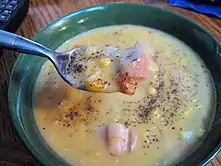
The origin of the term chowder is obscure. One possible source is the French word chaudron,[2][3] the French word for cauldron, the type of cooking or heating stove on which the first chowders were probably cooked.[4][5] Chodier was also a name for a cooking pot in the Creole language of the French Caribbean islands: Crab pas mache, li pas gras; li mache touop, et li tomber nans chodier ("if a crab don't walk, he don't get fat, if he walks too much, he falls into a cooking pot").[6] Note also the Portuguese, Brazilian, Galician and Basque fish and shellfish stew known as caldeirada which would appear to have a similar etymology.[7] Another possible source of the word "chowder" could be the French dish called chaudrée (sometimes spelled chauderée), which is a type of thick fish soup from the coastal regions of Charente-Maritime and Vendée.[8] Yet another etymology could be from Quebecois French, where chaudière means "bucket".[9]
Although in the sixteenth century in Cornwall and Devon a dialect word "jowter" was used to describe hawkers, particularly fish-sellers, with later variants "chowder" and "chowter", this is not cited by the Oxford English Dictionary as a possible source due to controversy regarding the origins of the dish itself. Though the earliest citation the OED gives for the word used in its current sense of a fish-based stew is American,[10] the journal kept by the young botanist Joseph Banks visiting the English and French Labrador fisheries in 1766 gives an account of chowder, "which I believe is Peculiar to this Country", and its preparation that shows it was unfamiliar, though "when well made a Luxury that the rich Even in England at Least in my opinion might be fond of It is a Soup made with a small Quantity of salt Pork cut into Small Slices a good deal of fish and Biscuit Boyled for about an hour".[11]
Chowder was not utterly unfamiliar in England at the time, as in Sir Launcelot Greaves (1762) Tobias Smollett has one character state, "My head sings and simmers like a pot of chowder".[5] A Manx sailor in his memoirs recalls a meal made aboard a British ship on a voyage through the Caribbean in 1786: "....we frequently served up a mess called chowder, consisting of a mixture of fresh fish, salt pork, pounded biscuit and onions; and which, when well seasoned and stewed, we found to be an excellent palatable dish." [12] Cookbooks of the period included recipes for "Chowder, a Sea Dish" which might be thicker than a soup: in 1830 an English baked dish made with salmon and potato was called a chowder.[13]
In Merriam-Webster's dictionary chowder is defined as "a thick soup or stew made of seafood or corn with potatoes and onions and milk or tomatoes".[14]
History
Chowder as it is known today originated as a shipboard dish, and was thickened with the use of hardtack.[3][15] Chowder was brought to North America with immigrants from England and France and seafarers more than 250 years ago and became popular as a delicious dish, and is now a widely used dish as it is simple to prepare.[16]
In 1890, in the magazine American Notes and Queries, it was said that the dish was of French origin. Among French settlers in Canada it was a custom to stew clams and fish laid in courses with bacon, sea biscuits, and other ingredients in a bucket called a "chaudière", and it thus came to be invented. Then the Native Americans adopted it as "chawder", which was then corrupted as "chowder" by the Yankees.[17] After the Revolutionary war, the Fourth of July was celebrated with picnics, fireworks, dances and dinners. The foods served varied, changing with the customs of each region. Chowder was one of the dishes commonly served for the celebrations in the Northern United States.[18]
In the United States, early chowder making is traced to New England.[19] It was a bowl of simmering chowder by the sea side that provided in its basic form "sustenance of body and mind – a marker of hearth and home, community, family and culture". It is a food which evolved along the coastal shoreline of New England as a "congerie" of simple things, very basic and cooked simply. It is a simple dish of salt and pepper, potatoes and onion, pork and fish, cream and hard crackers, and not a sophisticated dish of the elite. Its simplicity made it attractive and it became a regional dish of the New Englanders, and their favorite recipe was "chowder master".[20] "Symbolically, functionally, mnemonically or dynamically" chowder has become a powerful means for New Englanders to define themselves as a community, a rich community with a deep past and value that distinguishes their region from all others. The dish has been made there for a long time and is imbibed into the community culture.[21] Etta M. Madden and Martha L. Finch observe that chowder provides "visceral memories that provided feelings of familiarity, comfort and continuity".[21]
A recipe formulated and published in 1894 by Charles Ranhofer, a famous chef of Delmonico's restaurant, was called "Chowder de Lucines" and had ingredients of pork, clams, potato (sliced to a seven sixteenths-inch size), onion, parsley, tomato, crackers garnished by thyme, salt and pepper.[22] Others in the same family, totally different from the New England clam chowder, are: "Fulton Market style", introduced in 1904 and made from clams, tomatoes, allspice, cloves, red pepper, and Worcester sauce; a "Vegetable Clam Chowder" introduced in 1929 and made of clams, chopped onions, diced carrots, stewed tomatoes, and thyme; "Coney Island Clam Chowder"; "New York Clam Chowder"; and "Manhattan Clam Chowder", a late entry after 1930.[22]
In most cases, particularly in the Maritime Provinces, Canadian chowder is thinner and more seafood-forward than its creamier American counterparts.
Types
Chowder is a soup with cream or milk mixed with ingredients such as potatoes, sweet corn, smoked haddock, clams and prawns, etc. Some cream-style chowders do not use cream, and are instead prepared using milk and a roux to thicken them. Some of the popular variations are clam chowder and potatoes; seafood chowder; spiced haddock chowder; Irish fish chowder with soda bread; crayfish chowder; clam chowder with cod; British seaside chowder with saffron; thick smoked-haddock chowder; Raymond Blanc's light shellfish chowder; New England-style clam chowder with crunchy thyme breadcrumbs; smoked haddock chowder with leeks and sweetcorn; clam, broad bean and salami chowder; and many more. Almost always, no matter the type, chowder is garnished or dressed with chopped chives.[23] Chowder can be a comfort food,[3][24] especially during the winter months served with a nice piece of cornbread or buttermilk biscuit.[25]
Bermuda fish chowder
Considered a national dish of Bermuda,[26] the primary ingredients in Bermuda fish chowder include fish, tomato, and onion that is seasoned with black rum and a Sherry pepper sauce. The dish is of British origin, and was brought to the New World by the colonists.[26]
Clam chowder
Clam chowder is prepared with clams, diced potato, onion, and sometimes celery. It may be prepared as a cream-style or broth-style soup. Several variations of clam chowder exist, including New England clam chowder, which is a cream-style soup; Manhattan clam chowder, a broth-style soup prepared using tomato, vegetables and clams;[3][25] Rhode Island clam chowder, a broth-style soup prepared using tomato and clams with no vegetables, and alternatively a simple broth-style soup using clams;[25] New Jersey clam chowder; Delaware clam chowder; Hatteras clam chowder; and Minorcan clam chowder. In Connecticut clam chowder, milk is used instead of cream. New England clam chowder is made in a diverse variety of styles.[27]
Clam chowder may be prepared with fresh, steamed clams or canned clams.[28] The "clam liquor" from steamed or canned clams may be retained for use in the soup,[28] and fresh or bottled clam juice may be used.[3][29] 21 January is the National New England Clam Chowder Day.[30][31]
In the late 1800s clam chowder was introduced in New Zealand as an "American" dish and has become integral to New Zealand cuisine.[32] A variant of New Zealand clam chowder is "pipi chowder", also known as "pipi soup" made with New Zealand surf clams. "Pipi" comes from the indigenous Maori name for the shellfish.[33][34] Despite strong historical ties between New Zealand and Australia clam chowder is virtually unheard of in Australia and absent from Australian restaurant menus.
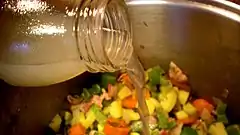 Bottled clam juice being used in preparation of clam chowder
Bottled clam juice being used in preparation of clam chowder
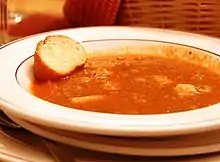
Corn chowder
Corn chowder is similar in consistency to New England clam chowder, with corn being used instead of clams. Additional vegetables that may be used in its preparation include potatoes, celery and onion.[35] Some are prepared using meats, such as chicken or bacon.[35] Corn chowder may be prepared with fresh, frozen, or canned corn.[36]
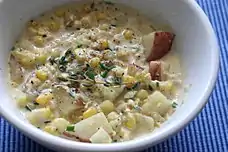 Roasted corn and potato chowder
Roasted corn and potato chowder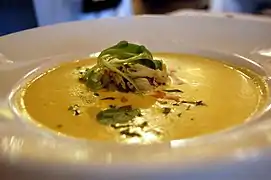 Corn chowder with crab
Corn chowder with crab
Fish chowder
Fish chowder is prepared with fish such as salmon or cod, and is similar to clam chowder in ingredients and texture. Ingredients used in fish chowder may include potato, onion, celery, carrot, corn and bacon.[37]
 A bowl of fish chowder, with tilapia, red potato, chopped dill, and other ingredients
A bowl of fish chowder, with tilapia, red potato, chopped dill, and other ingredients
Smoked salmon chowder
A popular dish in Pacific Northwest cuisine, smoked salmon chowder gets its red color from tomato paste and is prepared with celery, garlic, leeks, chives, potatoes and Alaskan smoked salmon. The best known smoked salmon chowders are made at Pike Place Market and by Ivar's Salmon House, both in Seattle, Washington.
Southern Illinois chowder
Southern Illinois Chowder, also referred to as "downtown chowder",[38] is a thick stew or soup that is very different from the New England and Manhattan chowders. The main ingredients are beef, chicken, tomatoes, cabbage, lima beans, and green beans.[38] Traditionally, squirrel meat was a common addition.[38][39] Southern Illinois chowder is a hearty dish that has been described as being closer in style to burgoo and Brunswick stew than coastal chowders.[38]
Seafood chowder
Seafood chowder is prepared with various types of seafood as a primary ingredient,[24] and may be prepared as a broth- or cream-style chowder. It is a popular menu item in New Zealand using ready-prepared mixed seafood, called "seafood marinara," "marinara mix", or simply "marinara." These terms are unique to New Zealand, Australia and South Africa.
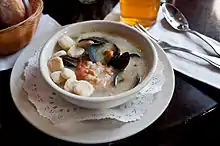 A cream-style seafood chowder at a restaurant, served with oyster crackers in the bowl at left
A cream-style seafood chowder at a restaurant, served with oyster crackers in the bowl at left
 A cream-style seafood chowder prepared with scallops and corn
A cream-style seafood chowder prepared with scallops and corn
Spiced haddock chowder
Spiced haddock chowder is made with haddock fillets, carrot, potato, plain flour, bay leaves, peppercorns, mustard, and spices added to milk and cooked in a pot with butter.[40]
Other types
The White Castle restaurant serves a potato and bacon chowder.[41]
Use of preserved clams
In North America, as people moved west, some homemade preparations of traditional chowder used canned or bottled clams when fresh clams were not available.[3] In some places the ingredients were modified based upon other locally available foods such as salmon, corn and chicken.[3]
Commercial varieties
Mass-produced, canned varieties of chowder are manufactured and purveyed to consumers, such as Campbell's and Progresso's New England Clam Chowder,[24] among other brands.
See also
- Bisque (food) – a smooth, creamy soup traditionally made with seafood
- Bobó de camarão – Brazilian shrimp chowder-like soup or stew
- Cioppino – a fish stew derived from Italian cuisine
- Cullen skink – the traditional Scottish haddock and milk stew
- Fish stew
- Jeongol – a chowder-like stew in Korean cuisine
- List of cream soups
- List of fish and seafood soups
- List of fish dishes
- List of seafood dishes
- List of soups
- List of stews
- Squid as food
- New England Great Chowder Cook-Off
References
- "Fish Chowders Make Goodly Fare" Brooklyn Eagle (11 March 1912): 22. via Newspapers.com

- Leslie Bilderback, CMB (2007). The Complete Idiot's Guide To Comfort Food. DK Publishing. p. 86. ISBN 978-1-4406-2617-3.
- "Ring in New Year with fresh chowder". The Seattle Times. 28 December 2015. Retrieved 19 January 2016.
- "Chowder Origins Still a Mystery" Fresno Bee (19 February 1969): 17. via Newspapers.com

- Hooker 1978, p. 2
- Fenger, Frederic Abildgaard (1917). Alone in the Caribbean. University of California Libraries. p. 21.
- "O que é Caldeirada". 15 November 2015. Retrieved 4 October 2018.
- Scalza, Remy. "14 Chowders + Craft Beer". Inside Vancouver. Retrieved 19 January 2016.
- "Les mots québécois du quotidien: vidange, chaudière, moppe et vadrouille". Traduction du Français au Français (in French). 15 April 2014. Retrieved 4 October 2018.
- "Directions for making a chouder"; Boston Evening Post, 23 September 1751
- O'Brien, Patrick (1987). Joseph Banks, A Life. p. 53.
- Crow, Hugh (1830). Memoirs of the late Captain Hugh Crow of Liverpool. p. 19.
- Hooker 1978, p. 100
- "chowder". Merriam Webster Dictionary. Retrieved 18 January 2016.
- Hooker 1978, p. 3.
- Hooker 1978, p. 1.
- Walker & Cox 2011, pp. 22–24.
- Smith, Andrew F. (2013). Food and Drink in American History: A "Full Course" Encyclopedia. ABC-CLIO. p. 364.
- Walker & Cox 2011, p. 9.
- Walker & Cox 2011, pp. 11–12.
- Walker & Cox 2011, p. 14.
- Hooker 1978, p. 9
- "Chowder recipes". BBC. Retrieved 18 January 2016.
- Tilley, M. (2011). Hold That Hidden Salt!: Recipes for Delicious Alternatives to Processed, Salt-heavy Supermarket Favourites. Formac Publishing Company Limited. pp. 58–59. ISBN 978-0-88780-952-1.
- "Creamy Chowder in Boston". Ultimate Food Journeys: The World's Best Dishes and Where to Eat Them. DK Publishing. 2011. p. 287. ISBN 978-0-7566-9588-0.
- Alper, N. (2008). The Everything Easy Gourmet Cookbook. F+W Media. p. 284. ISBN 978-1-60550-432-2.
- Worrall, Simon. "What's Best, Worst, and Most Weird About American Food". National Geographic. Retrieved 19 January 2016.
- Brody, J.E.; Flaste, R. (1994). Jane Brody's Good Seafood Book. Norton. p. 194. ISBN 978-0-393-03687-9.
- "Smoky bacon adds extra richness to creamy New England clam chowder". Today. 10 December 2015. Retrieved 19 January 2016.
- Dea, Cynthia. "National New England clam chowder day". Retrieved 21 January 2016.
- Smith, Emily. "National New England clam chowder day". Retrieved 21 January 2016.
- "The home of chowder in New Zealand". NZ Seafood Chowder Blog. Archived from the original on 27 August 2018. Retrieved 4 October 2018.
- "Pipi Soup (NZ Clam Chowder)". Food. Retrieved 15 September 2020.
- "Pipi Pie to Pipi Sandwiches, Recipes from a Vintage NZ Cook Book". Retrieved 4 October 2018.
- Rombauer, I.S.; Becker, M.R.; Becker, E.; Guarnaschelli, M. (1997). JOC All New Rev. – 1997. Scribner. p. 110. ISBN 978-0-684-81870-2.
- Thorne, J.; Thorne, M.L. (2000). Serious Pig: An American Cook in Search of His Roots. Farrar, Straus and Giroux. p. 309. ISBN 978-1-4668-0598-9.
- Stutman, Seth. "Sweet Potato Seafood "Chowder"". WWLP.com. Retrieved 18 January 2016.
- Stern, J.; Stern, M. (2011). The Lexicon of Real American Food. Globe Pequot Series. Lyons Press. p. 100. ISBN 978-0-7627-6094-7.
- Wells, Len (10 August 2008). "Tradition Is Ingredient in Bone Gap Chowder". Evansville Courier & Press. Archived from the original on 1 December 2008. Retrieved 12 January 2016.
- Torode, John. "Spiced haddock chowder". BBC. Retrieved 18 January 2016.
- "11 Fast Foods You Should Never Order". The Huffington Post. Retrieved 21 January 2016.
Bibliography
- Hooker, Richard James (January 1978). The Book of Chowder. Harvard Common Press. ISBN 978-0-916782-10-8.
- Walker, Jake; Cox, Robert S. (2011). A History of Chowder: Four Centuries of a New England Meal. The History Press. ISBN 978-1-60949-259-5.
Further reading
- Wentworth, Harold; Flexner, Stuart Berg (1967). Dictionary of American Slang. New York: Thomas Y. Crowell. ISBN 0-690-23602-6.
Chowderhead definition, in use since c. 1835
- Edwards County Historical Society (1980). A History of Edwards County, Illinois. 1. Higginson Book Company. ISBN 0-88107-219-2.
- The New England Chowder Compendium. Beatrice McIntosh Cookery Collection. University of Massachusetts.
- White, Jasper (2000). 50 Chowders. Simon and Schuster. ISBN 0684850346.
External links
- A history of Chowder. Linda Stradley. 2004.
.jpg.webp)


.jpg.webp)

